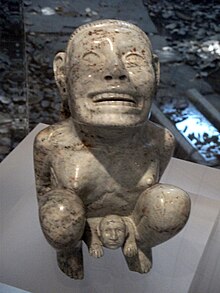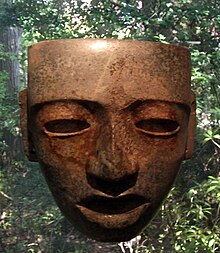Museum and collections[edit]
The Dumbarton Oaks Museum features collections of Byzantine and Pre-Columbian art, as well as European artworks and furnishings. Mildred and Robert Woods Bliss initiated these collections in the first half of the twentieth century and provided the vision for future acquisitions even after giving Dumbarton Oaks to Harvard University.
The Byzantine Collection spans the imperial, ecclesiastical, and secular realms and comprises more than 1,200 objects from the fourth to the fifteenth centuries. Although the collection emphasizes objects of precious materials, underscoring the conception of Byzantine art as luxury art, the collection also includes large-scale works such as mosaics from Antioch and relief sculpture, as well as more than two hundred textiles and comprehensive holdings of coins and seals. It owns four manuscripts (see, e.g., Minuscule 705). In addition to its Byzantine holdings, the collection includes Greek, Roman, and western medieval artworks and objects from the ancient Near East, pharaonic and Ptolemaic Egypt, and various Islamic cultures.
The Robert Woods Bliss Collection of Pre-Columbian Art comprises objects from the ancient cultures of Mesoamerica, the Intermediate Area, and the Andes. Among its most important holdings are a variety of sculptures in stone, including carvings of Aztec deities and animals and several large relief panels bearing the likenesses of Maya kings. In addition there are sculpted anthropomorphic figurines and polished jade renderings of ritual objects from the Olmec, Veracruz, and Teotihuacan cultures as well as molded and painted ceramics of the Nasca, Moche, and Wari cultures. Gold and silver objects from the Chavín, Lambayeque, Chimú, and Inca cultures offer evidence of the expertise achieved by Andean metalsmiths, and over forty textiles and works in feathers testify to the importance of fiber arts in this region.
The House Collection consists primarily of Dumbarton Oaks' historic buildings and interiors, Asian, European, and American artworks, and interior furnishings. Principal to the collection is the renaissance-style music room. The ceiling and flooring of this room were inspired by examples at the guardroom of the historic Château de Cheverny near Paris and were fabricated by the Parisian designer, Armand Albert Rateau. The music room features displays of tapestries, sculptures, paintings, and furniture dating from the fifteenth to the eighteenth centuries. The Blisses used the music room for hosting musical programs and scholarly lectures, and it continues to serve these purposes.
Philip Johnson Pre-Columbian Pavilion[edit]
In 1959, the Blisses commissioned the New York City architect Philip Johnson to design a pavilion for the Robert Woods Bliss Collection of Pre-Columbian Art. This building—eight domed circular galleries (having an unroofed fountain area at the center) set within a perfect square—recalls Islamic architecturalideas, and Johnson later credited the design to his interest in the early sixteenth-century Turkish architect Mimar Sinan.[15] The pavilion was built in the Copse, one of the designed landscapes at Dumbarton Oaks, and Johnson employed curved glass walls to blend the landscape with the building. He later reminisced that his idea was to fit a small pavilion into an existing treescape, to make the building become part of the Copse. Johnson maintained that he wanted the garden to “march right up to the museum displays and become part of them,”[16] with the plantings brushing the glass walls and the sound of splashing water audible in the central fountain. To further this idea, he incorporated four interior glazed planter areas situated between the galleries and the fountain.
Johnson also believed that the pavilion was to be best enjoyed from the inside. In addition to offering interesting garden views, the eight gallery spaces allow for a well-organized circulation plan. They also provide intimate areas for visitors to enjoy and study the Pre-Columbian objects. Each interconnected exhibition gallery is twenty-five feet in diameter, having curved glass walls supported by cylindrical columns sheathed in Illinois Agatan marble and shallow domes that rise from flat bronze rings. The floors are teak, laid radially and ended by wide rims of mottled green Vermont marble.[17][1



No comments:
Post a Comment